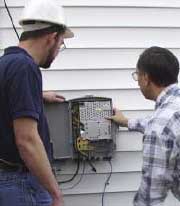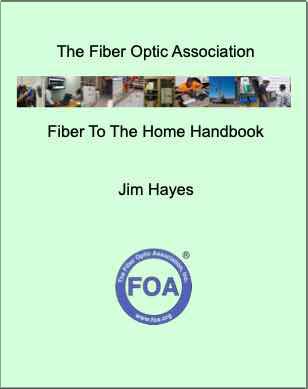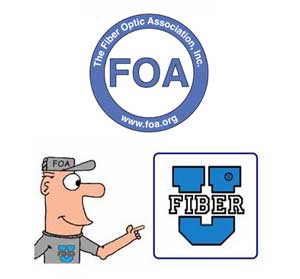FTTX
- Fiber To The Home, Curb, Wireless, etc.
Intended
For:
- Technicians
involved with designing, installing or operating FTTx
networks
- Designers
and installers involved
in FTTX projects
- Managers
and supervisors involved in FTTX projects
- Anyone
new to fiber to the home, curb, etc. (FTTX) or who
wants to learn how it works
- May
be used to prepare for the FOA Certified Fiber Optic
Specialist in FTTx certification (CFOS/H)
Objectives: From this self-study program you should learn:
- What is FTTx? - Fiber to the home, premises, curb,
node, etc.
- How FTTx developed and is growing worldwide
- Alternatives to FTTH
- Network architectures used in FTTx, specifications,
advantages/disadvantages
- What is a "triple-play" system and how is it
implemented?
- What are FTTx standards? BPON, GPON, EPON, RFOG, etc.
- How to plan, design and install a FTTx project
- How to test FTTx installations, especially PONs
- Prerequisites

When
you finish, you can take an online exam on this course to
qualify for a "Fiber U Certificate of Completion." See
below and Lesson 6 for instructions.
- Fiber
is now gaining acceptance in the final frontier of
telephone networks, the "last mile" - the
connection to the home. Many homes are still
connected with aging, low performance copper
telephone wire that cannot support connection
speeds for broadband access. The costs of
maintaining these old copper cable plants is also
extremely high and increasing.

Phone companies, cities, utilities and commercial
service providers are now realizing the ultimate
choice for upgrading the subscriber connection is
fiber to the premises or home (FTTP, FTTH, or
FTTx) although fiber to the curb (FTTC) or fiber
to wireless (FTTW) may be used where appropriate.
The possibility of delivering new services (the
"triple-play" of phone, Internet and video) and
low priced components for with new network
architectures make FTTx financially attractive for
the first time. Companies are committing billions
of dollars to plans for connecting millions of
homes and offices with fiber.
CATV companies are considering fiber to replace
coax, since the cost is reasonable and it offers
unlimited bandwidth. Municipalities or private
individuals are looking at installing their own
FTTx systems when phone or CATV companies won't do
it soon enough. Housing developers are learning
about FTTx because their customers are demanding
the highest bandwidth broadband connections.
All these plans depend on finding or training
adequate numbers of technicians. The FOA, working
with operating companies, municipalities,
installers and our approved schools has developed
requirements for FTTx training and certification,
with the goal of providing enough qualified FTTx
installation technicians to make these plans
possible.
- Those
interested in learning about FTTx will find the
courses good information on the current
technology.
- FOA
Certified Fiber Optic Specialist in FTTx
technician certification programs (CFOS/H)
are taught in many FOA-approved schools.
Those working in the field may qualify to take FOA
CFOS/H certification directly based on experience
and studying this course.
Prerequisites
It
is assumed that the student has a basic knowledge of fiber
optics at least at the basic CFOT or CFOS/H level. Review
of basic fiber optics can be done on the Fiber U website
with either the Basic
Fiber Optics
or OSP
Fiber Optics
self-study courses.
Student
Assignments
Students will be instructed to read the references, watch
videos and take the quizzes (Test Your Knowledge) to
complete the "classroom" part of the course. A FTTx design
case study is included where a typical network is
described and students will design the network on paper
and answer questions on the case study.
FOA
Certification
FOA
offers a specialist certification in FTTx (CFOS/H)
that is available to any CFOT. Many FOA
schools teach CFOS/H courses. Current FOA members
with appropriate industry experience may apply to take the
online course for credit toward their requirements for the
CFOS/H certification and apply for the certification exam.
Contact the FOA for more details and an application.
Reference Materials For This Course
The primary reference material for this course is
online at the FOA
Online Guide to Fiber Optics,
FTTx
Section which is regularly updated and expanded to
cover new developments in FTTx. The video and textbook
references are additional references.
Online FOA Reference
FOA
Online Reference Guide to Fiber Optics,
FTTx
Section
Reference
Textbook

The
Fiber Optic Association Fiber To The Home Handbook:
For Planners, Managers, Designers, Installers And
Operators Of FTTH - Fiber To The Home - Networks.
Available
from Amazon.com
in paperback and Kindle versions. Also at your bookseller.
also
FOA
Reference Guide to Outside Plant Fiber Optics,
Appendix B
Videos
FOA
YouTube Videos,
with individual links as appropriate
You
may, if you wish, watch the entire video and then watch
the referenced sections for a second time for greater
comprehension.
Extra
Credit Reading
Assignments beyond the basics required for the course will
be listed as extra credit.
Let's
Get Started:
Lesson
Plans
Lesson
Plan No. 1: Introduction To FTTx?
Lesson
Plan No. 2, FTTx Architectures
Lesson
Plan No. 3, FTTx PON Passive Optical Networks
Lesson
Plan No. 4, Designing FTTx Networks & Case Study
Lesson
Plan No. 5, Installing FTTx Networks
Lesson
Plan No. 6, Testing FTTx Networks
Lesson
Plan No 7: Planning and Managing FTTx Networks

When
you finish the assignments and case study, you can take an
online exam on this course to qualify for a "Fiber U
Certificate of Completion." The exam cost is $20US. More
on the Fiber
U Certificate of Completion. Here
are detail directions if this is your first time
taking a Fiber
U Certificate of Completion exam.
Go
here to take the Fiber U FTTX Certificate of
Completion exam.
This information
is provided by The Fiber Optic Association, Inc. as a
benefit to those interested in teaching, designing,
manufacturing, selling, installing or using fiber optic
communications systems or networks. It is intended to be
used as an overview and/or basic guidelines and in no way
should be considered to be complete or comprehensive.
These guidelines are strictly the opinion of the FOA and
the reader is expected to use them as a basis for
learning, as a reference and for creating their own
documentation, project specifications, etc. Those working
with fiber optics in the classroom, laboratory or field
should follow all safety rules carefully. The FOA assumes
no liability for the use of any of this material.
|

